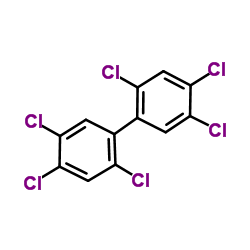PCB-153

PCB-153 structure
|
Common Name | PCB-153 | ||
|---|---|---|---|---|
| CAS Number | 35065-27-1 | Molecular Weight | 360.878 | |
| Density | 1.6±0.1 g/cm3 | Boiling Point | 396.2±37.0 °C at 760 mmHg | |
| Molecular Formula | C12H4Cl6 | Melting Point | 103-104ºC | |
| MSDS | Chinese USA | Flash Point | 193.2±23.9 °C | |
| Symbol |


GHS08, GHS09 |
Signal Word | Warning | |
|
Cross-omics gene and protein expression profiling in juvenile female mice highlights disruption of calcium and zinc signalling in the brain following dietary exposure to CB-153, BDE-47, HBCD or TCDD.
Toxicology 321 , 1-12, (2014) The present study assessed if eating a diet of fish, spiked with persistent organic pollutants (POPs), affects gene and protein expression in the maturing mouse brain. Juvenile female Balb/c mice (22 days of age) were exposed for 28 days to fish-based diets s... |
|
|
Associations of accumulated exposure to persistent organic pollutants with serum lipids and obesity in an adult cohort from Southern Spain.
Environ. Pollut. 195 , 9-15, (2014) The aim of this research was to study the association of the accumulated human exposure to persistent organic pollutants with serum lipid levels and obesity, in a cohort of 298 adults. In the multivariable analyses, HCB concentrations evidenced a significant ... |
|
|
Temporal dynamics of circulating persistent organic pollutants in a fasting seabird under different environmental conditions.
Environ. Sci. Technol. 46(18) , 10287-94, (2012) Temporal dynamics of persistent organic pollutants (POPs) were examined in fasting common eider (Somateria mollissima) females in one subarctic (68° N; over 5 years) and one high arctic colony (78° N; 3 years). Blood concentrations of polychlorinated biphenyl... |
|
|
Plasma concentrations of organohalogenated pollutants in predatory bird nestlings: associations to growth rate and dietary tracers.
Environ. Toxicol. Chem. 32(11) , 2520-7, (2013) The extent to which persistent organic pollutants (POPs) with different physicochemical properties originated from the food (dietary input) was assessed in raptor nestlings. Lipophilic polychlorinated biphenyl (PCB) 153, 1-dichloro-2,2-bis(p-chlorophenyl)ethy... |
|
|
Evaluating the neurotoxic effects of lactational exposure to persistent organic pollutants (POPs) in Spanish children.
Neurotoxicology 34 , 9-15, (2013) Although the brain continues developing in the postnatal period, epidemiological studies on the effects of postnatal exposure to neurotoxic POPs through breast-feeding remain mostly inconclusive. Failure to detect associations between postnatal exposure and h... |
|
|
Regulation of pregnane-X-receptor, CYP3A and P-glycoprotein genes in the PCB-resistant killifish (Fundulus heteroclitus) population from New Bedford Harbor.
Aquat. Toxicol. 159 , 198-207, (2015) Killifish survive and reproduce in the New Bedford Harbor (NBH) in Massachusetts (MA), USA, a site severely contaminated with polychlorinated biphenyls (PCBs) for decades. Levels of 22 different PCB congeners were analyzed in liver from killifish collected in... |
|
|
Tumor promoting effects of cyanobacterial extracts are potentiated by anthropogenic contaminants--evidence from in vitro study.
Chemosphere 89(1) , 30-7, (2012) Inhibition of gap junctional intercellular communication (GJIC) is affiliated with tumor promotion process and it has been employed as an in vitro biomarker for evaluation of tumor promoting effects of chemicals. In the present study we investigated combined ... |
|
|
Food web-specific biomagnification of persistent organic pollutants.
Science 317 , 236-9, (2007) Substances that accumulate to hazardous levels in living organisms pose environmental and human-health risks, which governments seek to reduce or eliminate. Regulatory authorities identify bioaccumulative substances as hydrophobic, fat-soluble chemicals havin... |
|
|
Long-term trends of continental-scale PCB patterns studied using a global atmosphere-ocean general circulation model.
Environ. Sci. Pollut. Res. Int. 19(6) , 1971-80, (2012) Continental-scale distribution and inter-continental transport of four polychlorinated biphenyl (PCB) congeners (28, 101, 153, 180) from 1950 to 2010 were studied using the global multicompartment chemistry transport model MPI-MCTM. Following identical primar... |
|
|
Non-coplanar polychlorinated biphenyls (PCBs) are direct agonists for the human pregnane-X receptor and constitutive androstane receptor, and activate target gene expression in a tissue-specific manner.
Toxicol. Appl. Pharmacol. 263(1) , 7-13, (2012) The polychlorinated biphenyl group possesses high environmental persistence, leading to bioaccumulation and a number of adverse effects in mammals. Whilst coplanar PCBs elicit their toxic effects through agonism of the aryl hydrocarbon receptor; however, non-... |